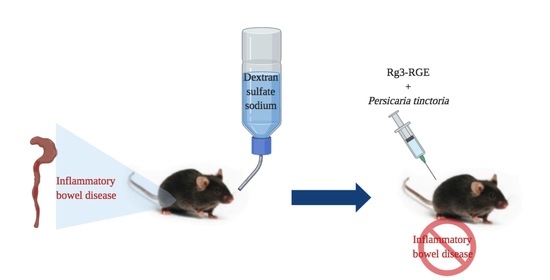Alleviation of Ulcerative Colitis Potentially through th1/th2 Cytokine Balance by a Mixture of Rg3-enriched Korean Red Ginseng Extract and Persicaria tinctoria
Abstract
1. Introduction
2. Results
2.1. Bioactive Compounds in Rg3-RGE and PT
2.2. Rg3-RGE + PT Synergistically Attenuated LPS-Induced Inflammation
2.3. Effects of Rg3-RGE + PT on the Expression of Pro-Inflammatory Mediators and Cytokines at the Transcriptional and Translational Levels
2.4. Signal Transduction of Rg3-RGE + PT via NF-κB and Mitogen-Activated Protein Kinase (MAPK) Pathways
2.5. Preventive Role of Rg3-RGE + PT in DSS-Induced Colitis
2.6. Effects on Cytokine Production in DSS-Induced Colitis Mice
2.7. Transcriptional Suppression of Pro-Inflammatory Mediators and Cytokines and Signal Transduction of Rg3-RGE + PT via NF-κB in Colon Tissue
2.8. Effects of Rg3-RGE + PT on Immune Cell Subtypes in Spleen
3. Discussion
4. Materials and Methods
4.1. Chemicals and Reagents
4.2. Sample Preparation
4.3. Cell Culture
4.4. Nitric Oxide (NO) Assay
4.5. Cell Viability (MTT) Assay
4.6. DSS-Induced Colitis Model and Ginseng Mixture Treatment Regimens
4.7. RNA Extraction and Polymerase Chain Reaction (PCR)
4.8. Western Blot Analysis
4.9. Gross Examination of Colon and Disease Activity Index (DAI)
4.10. Enzyme Linked Immunosorbent Assay (ELISA) for Cytokines
4.11. Hematoxylin and Eosin (H&E) Staining
4.12. Fluorescent Antibody Cell Sorting (FACS)
4.13. Estimation of Th1/Th2 Cytokines Using ELISA
4.14. Statistical Analysis
5. Conclusions
Author Contributions
Funding
Acknowledgments
Conflicts of Interest
References
- Podolsky, D.K. Inflammatory Bowel Disease. N. Engl. J. Med. 2002, 347, 417–429. [Google Scholar] [CrossRef] [PubMed]
- Tontini, G.E.; Vecchi, M.; Pastorelli, L.; Neurath, M.F.; Neumann, H. Differential diagnosis in inflammatory bowel disease colitis: State of the art and future perspectives. World J. Gastroenterol. 2015, 21, 21–46. [Google Scholar] [CrossRef] [PubMed]
- Woo, J.K.; Choi, S.; Kang, J.-H.; Kim, D.E.; Hurh, B.-S.; Jeon, J.-E.; Kim, S.Y.; Oh, S.H. Fermented barley and soybean (BS) mixture enhances intestinal barrier function in dextran sulfate sodium (DSS)-induced colitis mouse model. BMC Complement. Altern. Med. 2016, 16, 498. [Google Scholar] [CrossRef] [PubMed]
- Zaki, H.; Boyd, K.L.; Vogel, P.; Kastan, M.B.; Lamkanfi, M.; Kanneganti, T.-D. The NLRP3 Inflammasome Protects against Loss of Epithelial Integrity and Mortality during Experimental Colitis. Immunity 2010, 32, 379–391. [Google Scholar] [CrossRef] [PubMed]
- Praengam, K.; Sahasakul, Y.; Kupradinun, P.; Sakarin, S.; Sanitchua, W.; Rungsipipat, A.; Rattanapinyopituk, K.; Angkasekwinai, P.; Changsri, K.; Mhuantong, W.; et al. Brown rice and retrograded brown rice alleviate inflammatory response in dextran sulfate sodium (DSS)-induced colitis mice. Food Funct. 2017, 8, 4630–4643. [Google Scholar] [CrossRef] [PubMed]
- Bauer, C.; Duewell, P.; Mayer, C.; Lehr, H.A.; Fitzgerald, K.A.; Dauer, M.; Tschopp, J.; Endres, S.; Latz, E.; Schnurr, M. Colitis induced in mice with dextran sulfate sodium (DSS) is mediated by the NLRP3 inflammasome. Gut 2010, 59, 1192–1199. [Google Scholar] [CrossRef]
- Zhou, W.; Liu, X.; Zhang, X.; Tang, J.; Li, Z.; Wang, Q.; Hu, R. Oroxylin A inhibits colitis by inactivating NLRP3 inflammasome. Oncotarget 2017, 8, 58903–58917. [Google Scholar] [CrossRef]
- Kiefer, D.; Pantuso, T. Panax ginseng. Am. Fam. Physician 2003, 68, 1539–1542. [Google Scholar]
- Lee, C.H.; Kim, J.-H. A review on the medicinal potentials of ginseng and ginsenosides on cardiovascular diseases. J. Ginseng Res. 2014, 38, 161–166. [Google Scholar] [CrossRef]
- Yao, Q.; Chen, C. Ginseng Compounds: An Update on their Molecular Mechanisms and Medical Applications. Curr. Vasc. Pharmacol. 2009, 7, 293–302. [Google Scholar] [CrossRef]
- Kim, S.M.; Lee, S.Y.; Cho, J.S.; Son, S.M.; Choi, S.S.; Yun, Y.P.; Yoo, H.S.; Yoon, D.Y.; Oh, K.-W.; Han, S.B.; et al. Combination of ginsenoside Rg3 with docetaxel enhances the susceptibility of prostate cancer cells via inhibition of NF-κB. Eur. J. Pharmacol. 2010, 631, 1–9. [Google Scholar] [CrossRef] [PubMed]
- Kim, B.-M.; Kim, D.-H.; Park, J.-H.; Na, H.-K.; Dong, Z. Ginsenoside Rg3 Induces Apoptosis of Human Breast Cancer (MDA-MB-231) Cells. J. Cancer Prev. 2013, 18, 177–185. [Google Scholar] [CrossRef] [PubMed]
- Kim, S.-J.; Jang, T.-W.; Kim, D.-W.; Park, J.H. Study on Antioxidant and Anti-inflammatory Activities of Persicaria tinctoria. Korea J. Herbol. 2015, 30, 17–24. [Google Scholar] [CrossRef]
- Coleman, J.W. Nitric oxide in immunity and inflammation. Int. Immunopharmacol. 2001, 1, 1397–1406. [Google Scholar] [CrossRef]
- Dinarello, C.A. Proinflammatory Cytokines. Chest 2000, 118, 503–508. [Google Scholar] [CrossRef] [PubMed]
- Li, Q.; Verma, I.M. NF-κB regulation in the immune system. Nat. Rev. Immunol. 2002, 2, 725–734. [Google Scholar] [CrossRef] [PubMed]
- Zhang, W.; Liu, H.T. MAPK signal pathways in the regulation of cell proliferation in mammalian cells. Cell Res. 2002, 12, 9–18. [Google Scholar] [CrossRef]
- Geboes, K.; Riddell, R.; Öst, A.; Jensfelt, B.; Persson, T.; Löfberg, R. A reproducible grading scale for histological assessment of inflammation in ulcerative colitis. Gut 2000, 47, 404–409. [Google Scholar] [CrossRef]
- Okayasu, I.; Hatakeyama, S.; Yamada, M.; Ohkusa, T.; Inagaki, Y.; Nakaya, R. A novel method in the induction of reliable experimental acute and chronic ulcerative colitis in mice. Gastroenterology 1990, 98, 694–702. [Google Scholar] [CrossRef]
- Chassaing, B.; Aitken, J.D.; Malleshappa, M.; Vijay-Kumar, M. Dextran Sulfate Sodium (DSS)-Induced Colitis in Mice. Curr. Protoc. Immunol. 2014, 104, 15.25.1–15.25.14. [Google Scholar] [CrossRef]
- Jang, H.-G.; Heo, B.-G.; Park, Y.S.; Namieśnik, J.; Barasch, D.; Katrich, E.; Vearasilp, K.; Trakhtenberg, S.; Gorinstein, S. Chemical Composition, Antioxidant and Anticancer Effects of the Seeds and Leaves of Indigo (Polygonum tinctorium Ait.) Plant. Appl. Biochem. Biotechnol. 2012, 167, 1986–2004. [Google Scholar] [CrossRef] [PubMed]
- Wiart, C. Medicinal Plants of China, Korea, and Japan; CRC Press: Boca Raton, FL, USA, 2012; p. 454. [Google Scholar]
- Angelini, L.G.; Tozzi, S.; O Di Nasso, N.N. Environmental Factors Affecting Productivity, Indican Content, and Indigo Yield inPolygonum tinctoriumAit., a Subtropical Crop Grown under Temperate Conditions. J. Agric. Food Chem. 2004, 52, 7541–7547. [Google Scholar] [CrossRef] [PubMed]
- Saba, E.; Kim, S.-H.; Kim, S.-D.; Park, S.-J.; Kwak, D.-M.; Oh, J.-H.; Park, C.-K.; Rhee, M.H. Alleviation of diabetic complications by ginsenoside Rg3-enriched red ginseng extract in western diet-fed LDL–/– mice. J. Ginseng Res. 2018, 42, 352–355. [Google Scholar] [CrossRef] [PubMed]
- Watanabe, T.; Yamamoto, T.; Yoshida, M.; Fujiwara, K.; Kageyama-Yahara, N.; Kuramoto, H.; Shimada, Y.; Kadowaki, M. The Traditional Herbal Medicine Saireito Exerts Its Inhibitory Effect on Murine Oxazolone-Induced Colitis via the Induction of Th1-Polarized Immune Responses in the Mucosal Immune System of the Colon. Int. Arch. Allergy Immunol. 2010, 151, 98–106. [Google Scholar] [CrossRef]
- Kumar, H.; Kawai, T.; Akira, S. Toll-like receptors and innate immunity. Biochem. Biophys. Res. Commun. 2009, 388, 621–625. [Google Scholar] [CrossRef]
- Cho, E.-J.; Shin, J.-S.; Noh, Y.-S.; Cho, Y.-W.; Hong, S.-J.; Park, J.-H.; Lee, J.Y.; Lee, J.-Y.; Lee, K.-T. Anti-inflammatory effects of methanol extract of Patrinia scabiosaefolia in mice with ulcerative colitis. J. Ethnopharmacol. 2011, 136, 428–435. [Google Scholar] [CrossRef]
- Kristensen, N.N.; Claesson, M.H. Future targets for immune therapy in colitis? Endocrine, Metab. Immune Disord. Drug Targets 2008, 8, 295–300. [Google Scholar] [CrossRef]
- Saba, E.; Jeong, D.; Irfan, M.; Lee, Y.Y.; Park, S.-J.; Park, C.-K.; Rhee, M.H. Anti-Inflammatory Activity of Rg3-Enriched Korean Red Ginseng Extract in Murine Model of Sepsis. Evid. Based Complement. Altern. Med. 2018, 2018, 6874692. [Google Scholar] [CrossRef]
- Saba, E.; Irfan, M.; Jeong, D.; Ameer, K.; Lee, Y.Y.; Park, C.-K.; Hong, S.-B.; Rhee, M.H. Mediation of antiinflammatory effects of Rg3-enriched red ginseng extract from Korean Red Ginseng via retinoid X receptor α-peroxisome-proliferating receptor γ nuclear receptors. J. Ginseng Res. 2018, 43, 442–451. [Google Scholar] [CrossRef]
- Wang, J.; Fang, X.; Ge, L.; Cao, F.; Zhao, L.; Wang, Z.; Xiao, W. Antitumor, antioxidant and anti-inflammatory activities of kaempferol and its corresponding glycosides and the enzymatic preparation of kaempferol. PLoS ONE 2018, 13, e0197563. [Google Scholar] [CrossRef]
- Lesjak, M.; Beara, I.; Simin, N.; Pintać, D.; Majkić, T.; Bekvalac, K.; Orčić, D.; Mimica-Dukić, N. Antioxidant and anti-inflammatory activities of quercetin and its derivatives. J. Funct. Foods 2018, 40, 68–75. [Google Scholar] [CrossRef]
- Zhang, Z.-L.; Fan, H.-Y.; Yang, M.-Y.; Zhang, Z.-K.; Liu, K. Therapeutic effect of a hydroxynaphthoquinone fraction on dextran sulfate sodium-induced ulcerative colitis. World J. Gastroenterol. 2014, 20, 15310–15318. [Google Scholar] [CrossRef] [PubMed]
- Docena, G.; Rovedatti, L.; Kruidenier, L.; Fanning, A.; Leakey, N.A.B.; Knowles, C.H.; Lee, K.; Shanahan, F.; Nally, K.; McLean, P.G.; et al. Down-regulation of p38 mitogen-activated protein kinase activation and proinflammatory cytokine production by mitogen-activated protein kinase inhibitors in inflammatory bowel disease. Clin. Exp. Immunol. 2010, 162, 108–115. [Google Scholar] [CrossRef]
- Menu, P.; Vince, J.E. The NLRP3 inflammasome in health and disease: The good, the bad and the ugly. Clin. Exp. Immunol. 2011, 166, 1–15. [Google Scholar] [CrossRef] [PubMed]
- Wu, X.-F.; Ouyang, Z.-J.; Feng, L.-L.; Chen, G.; Guo, W.-J.; Shen, Y.; Wu, X.-D.; Sun, Y.; Xu, Q. Suppression of NF-κB signaling and NLRP3 inflammasome activation in macrophages is responsible for the amelioration of experimental murine colitis by the natural compound fraxinellone. Toxicol. Appl. Pharmacol. 2014, 281, 146–156. [Google Scholar] [CrossRef] [PubMed]
- Deroche, T.C.; Xiao, S.-Y.; Liu, X. Histological evaluation in ulcerative colitis. Gastroenterol. Rep. 2014, 2, 178–192. [Google Scholar] [CrossRef] [PubMed]
- Neuman, M.G. Signaling for inflammation and repair in inflammatory bowel disease. Romanian J. Gastroenterol. 2004, 13, 309–316. [Google Scholar]
- Hundorfean, G.; Neurath, M.F.; Mudter, J. Functional relevance of T helper 17 (Th17) cells and the IL-17 cytokine family in inflammatory bowel disease. Inflamm. Bowel Dis. 2012, 18, 180–186. [Google Scholar] [CrossRef]
- Eichele, D.D.; Kharbanda, K.K. Dextran sodium sulfate colitis murine model: An indispensable tool for advancing our understanding of inflammatory bowel diseases pathogenesis. World J. Gastroenterol. 2017, 23, 6016–6029. [Google Scholar] [CrossRef]
- Saba, E.; Lee, Y.Y.; Kim, M.; Hyun, S.-H.; Park, C.-K.; Son, E.; Kim, D.-S.; Kim, S.-D.; Rhee, M.H. A novel herbal formulation consisting of red ginseng extract and Epimedium koreanum Nakai-attenuated dextran sulfate sodium-induced colitis in mice. J. Ginseng Res. 2020. [Google Scholar] [CrossRef]
- Sann, H.; Von Erichsen, J.; Hessmann, M.; Pahl, A.; Hoffmeyer, A. Efficacy of drugs used in the treatment of IBD and combinations thereof in acute DSS-induced colitis in mice. Life Sci. 2013, 92, 708–718. [Google Scholar] [CrossRef] [PubMed]
- Kim, E.-J.; Lee, H.-A.; Lee, B.-S.; Park, S.-J.; Kim, J.W. Platycodon grandiflorus alleviates DNCB-induced atopy-like dermatitis in NC/Nga mice. Indian J. Pharmacol. 2012, 44, 469–474. [Google Scholar] [CrossRef] [PubMed]
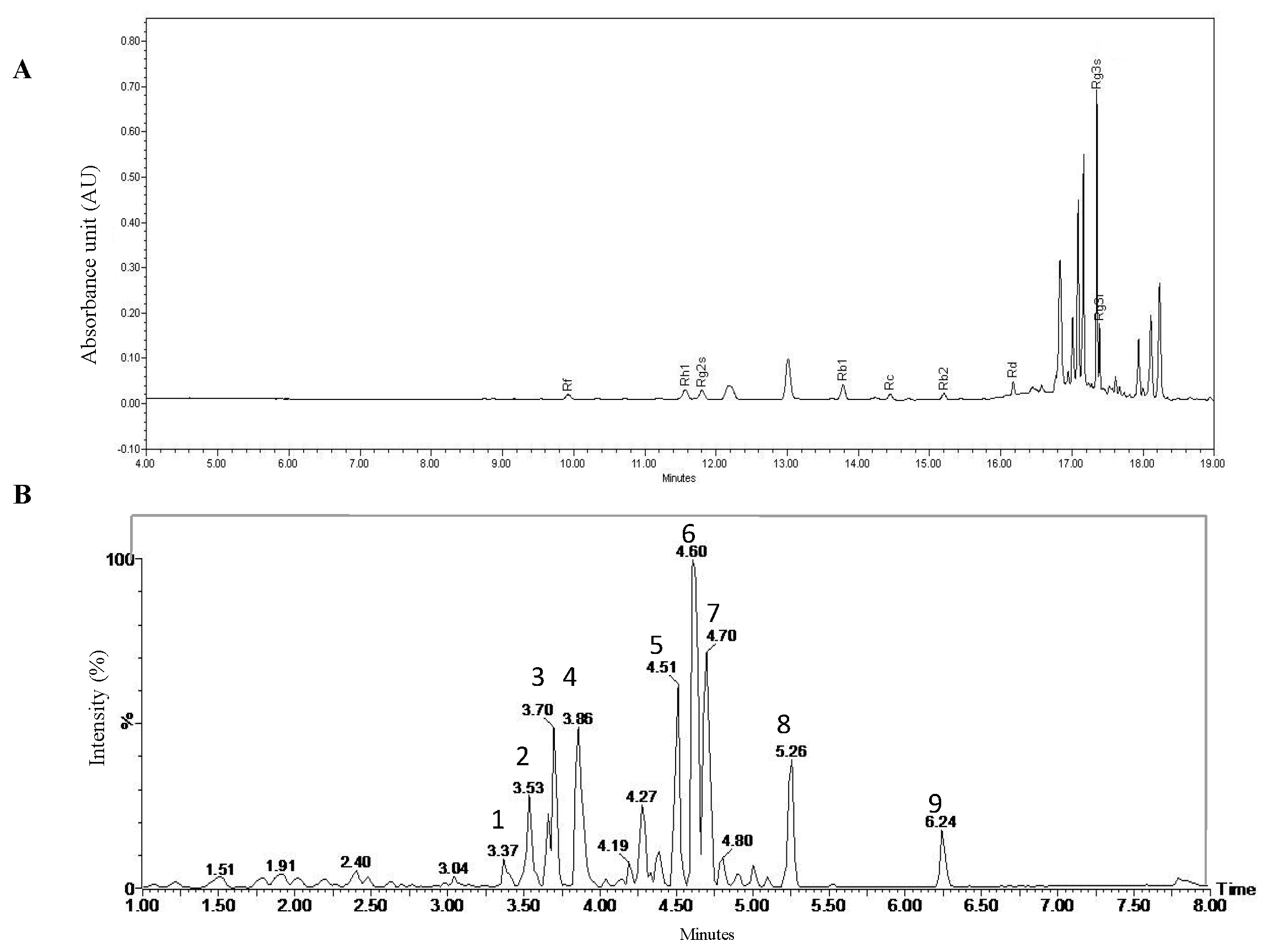
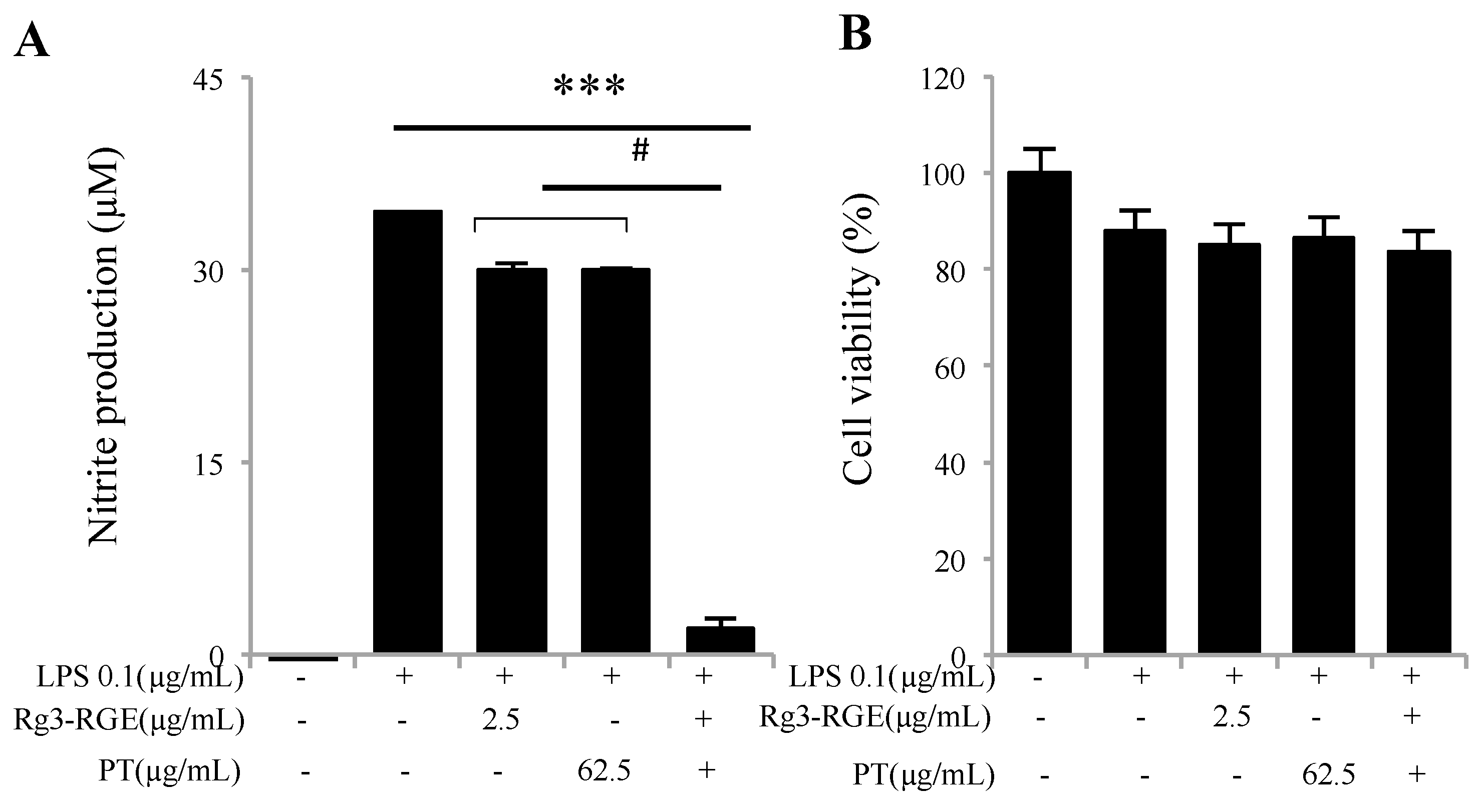
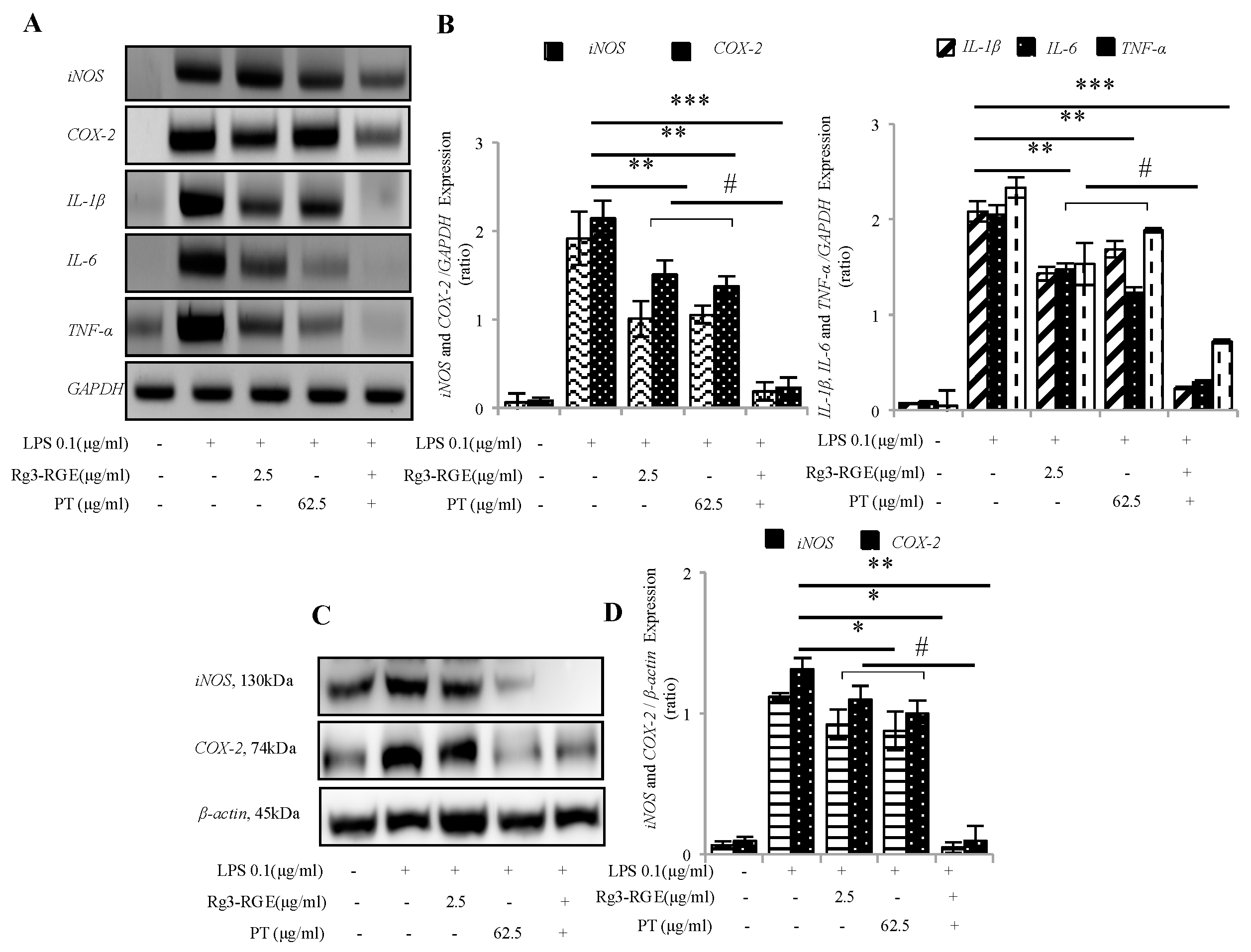
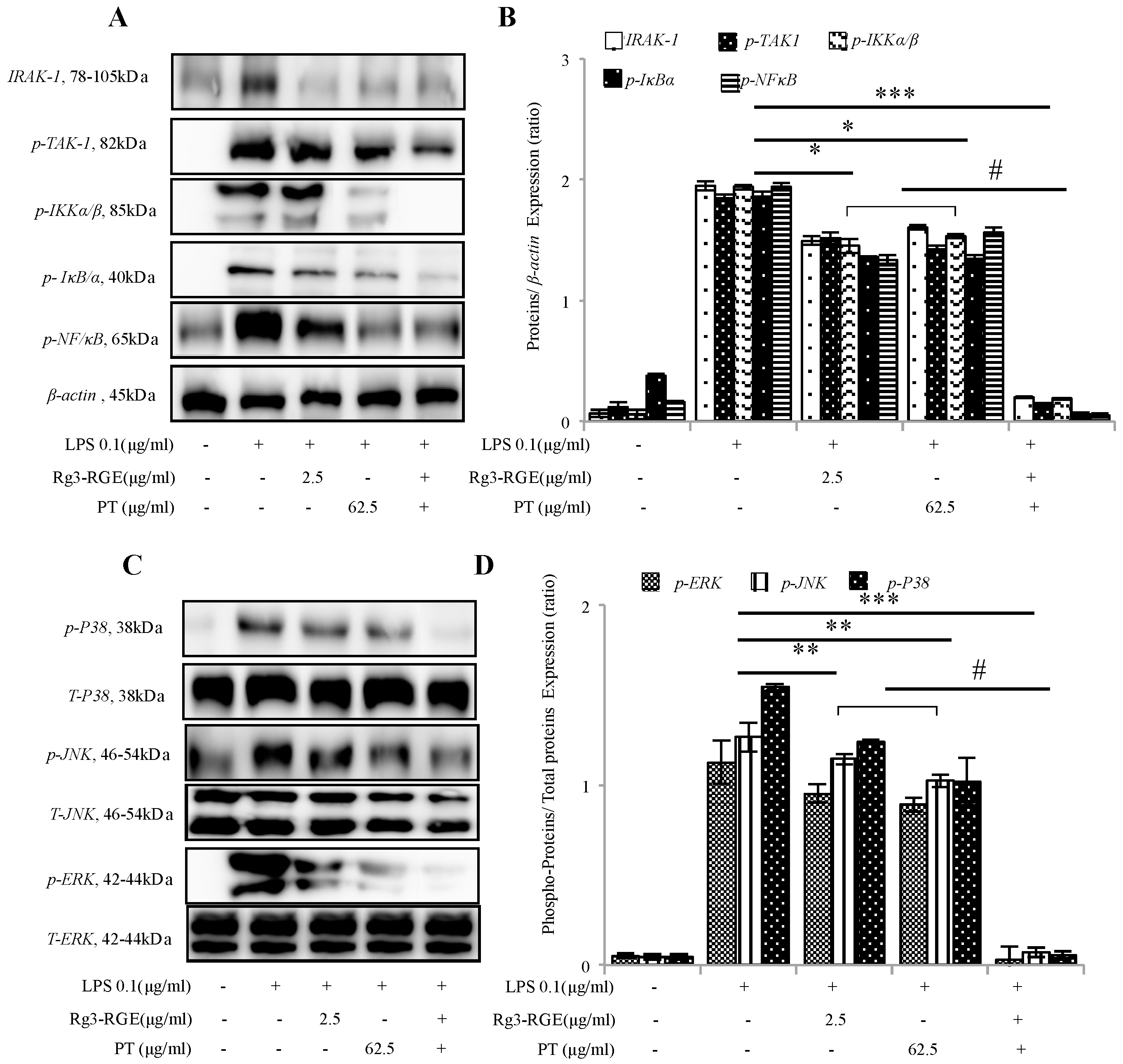
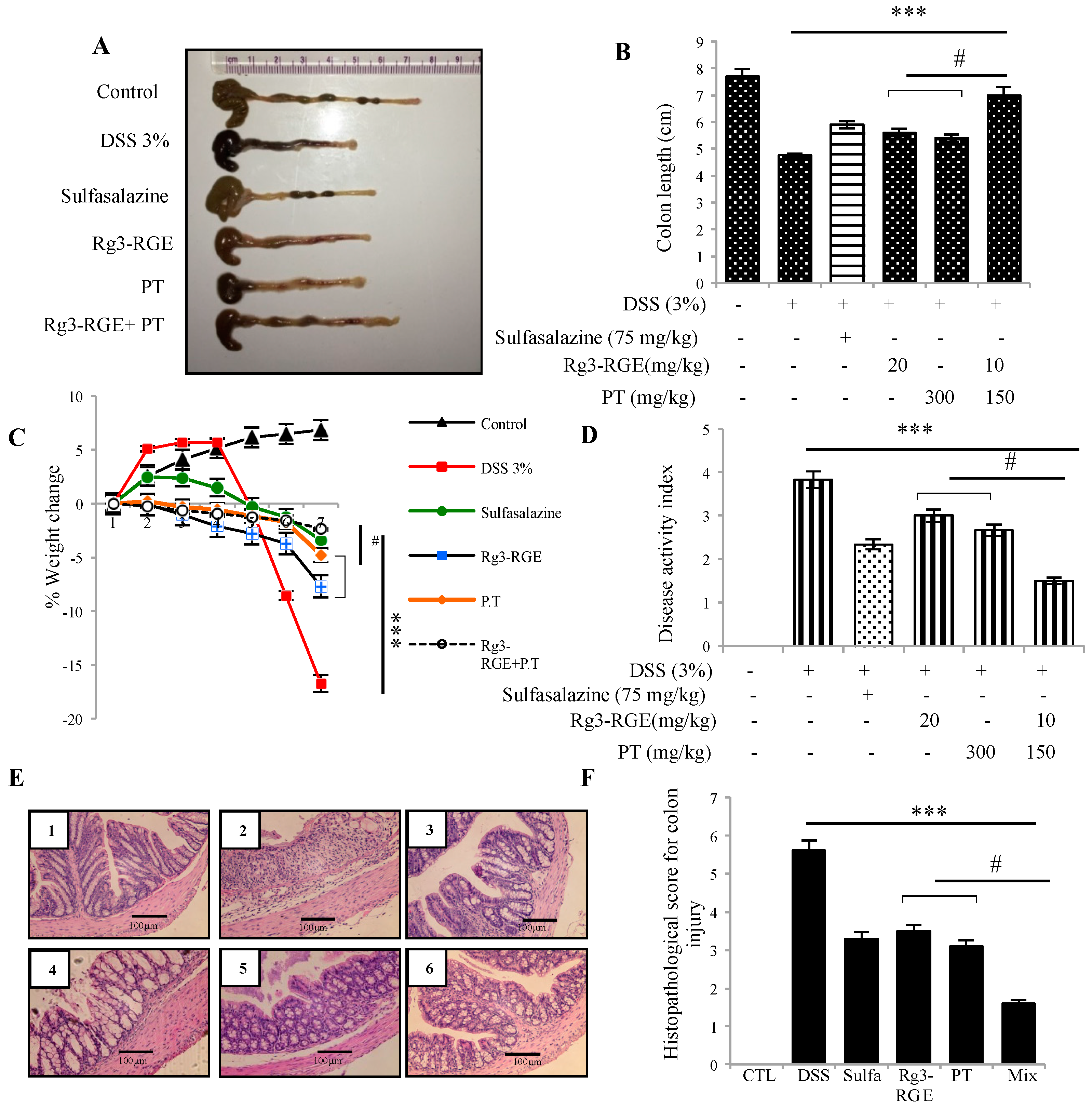
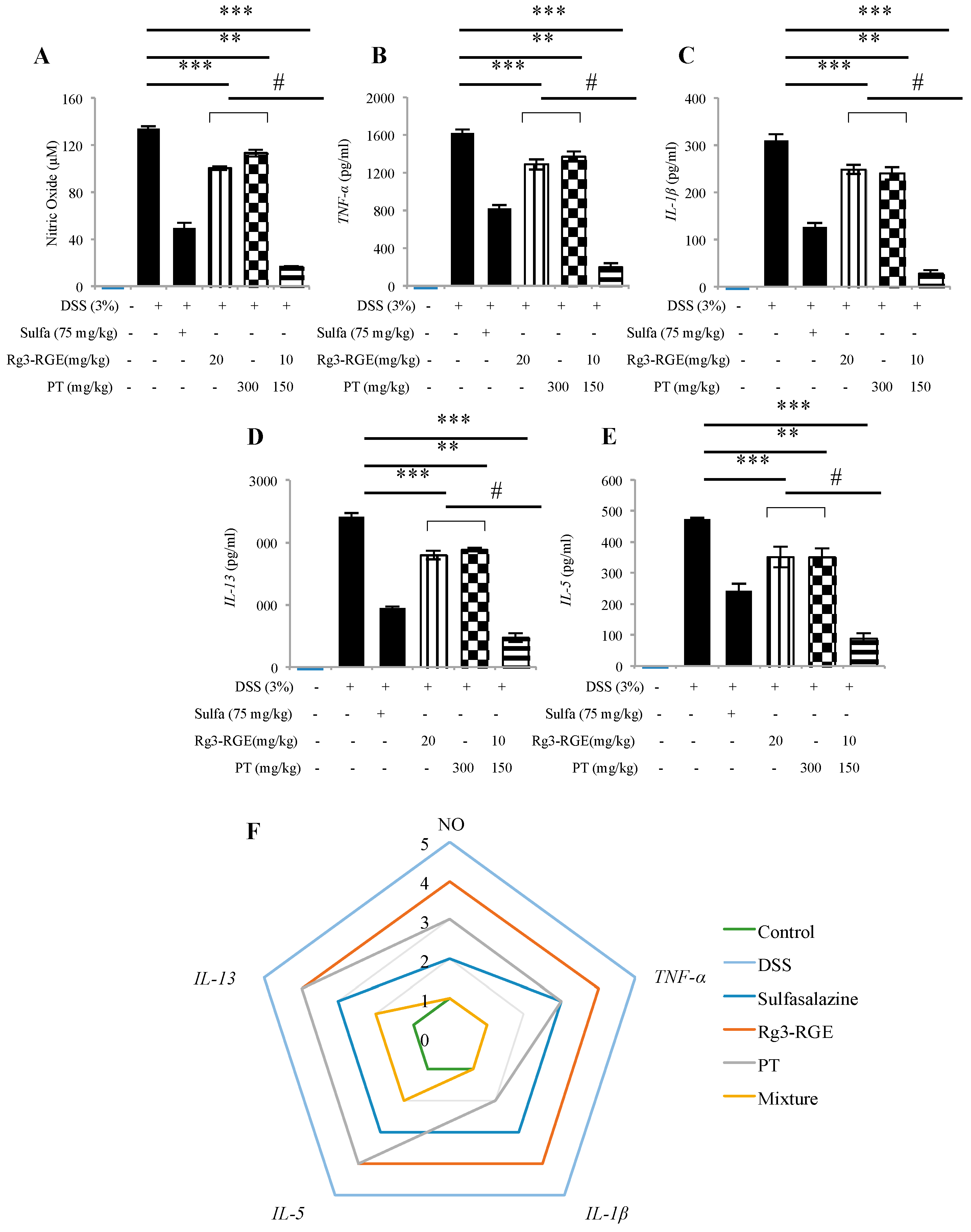
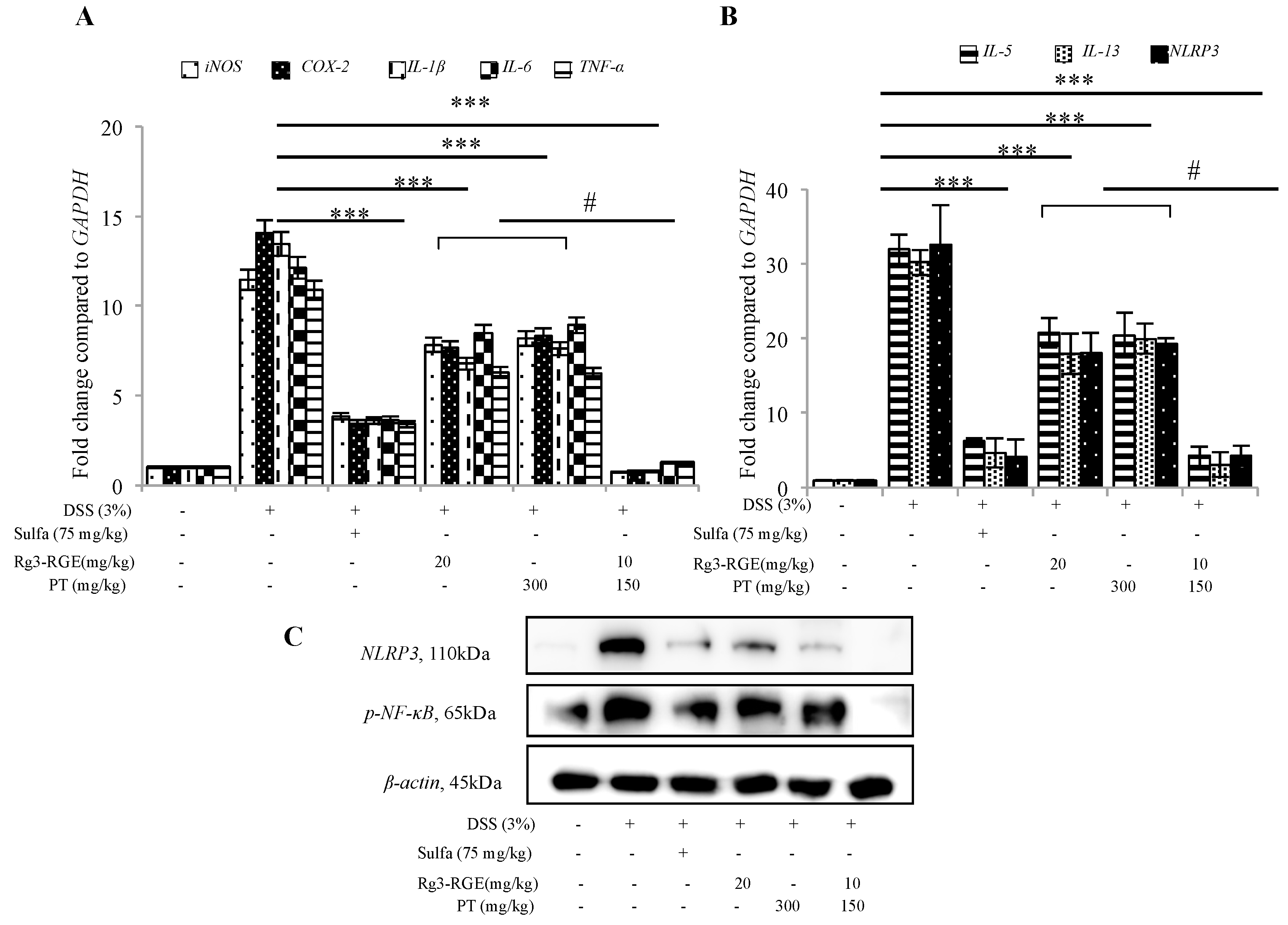
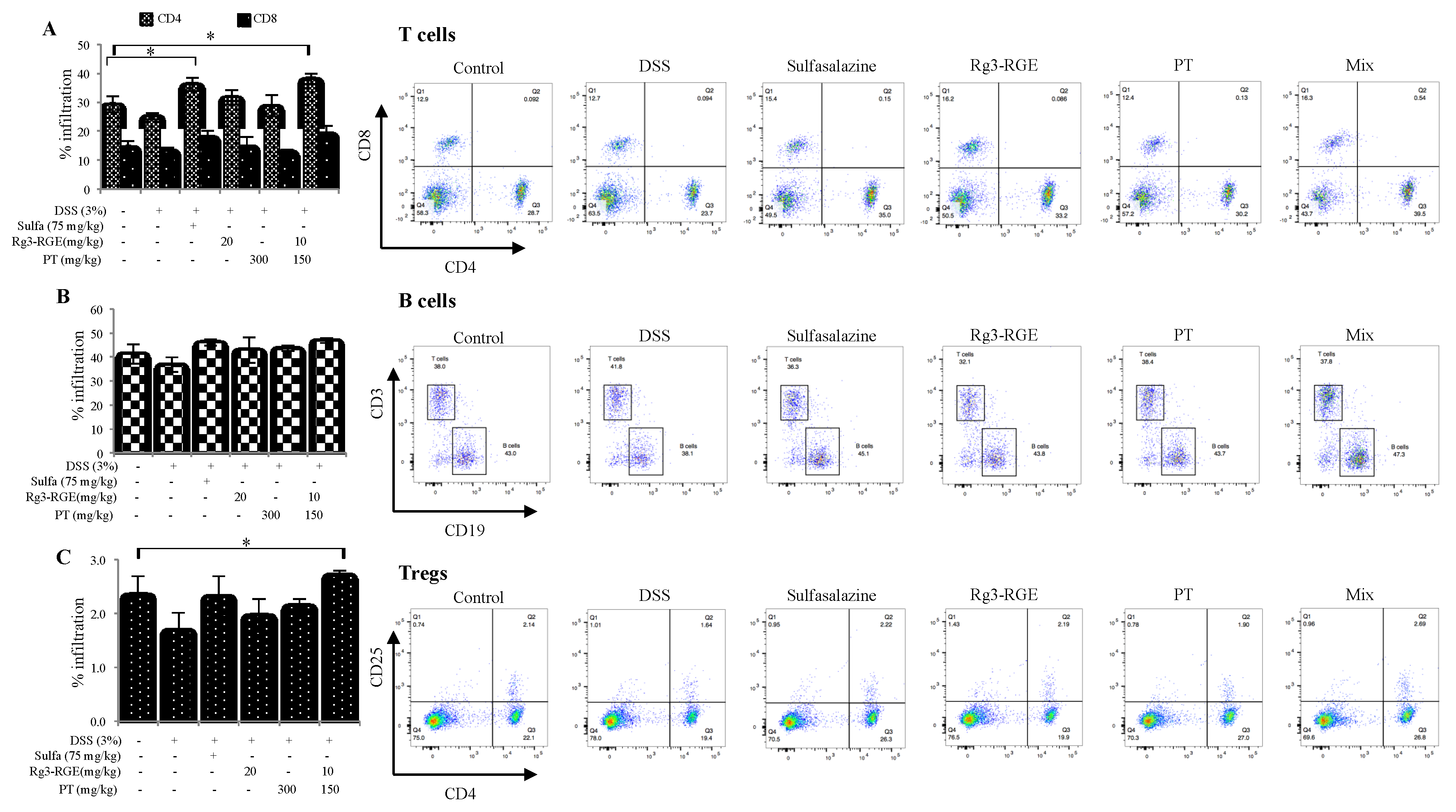
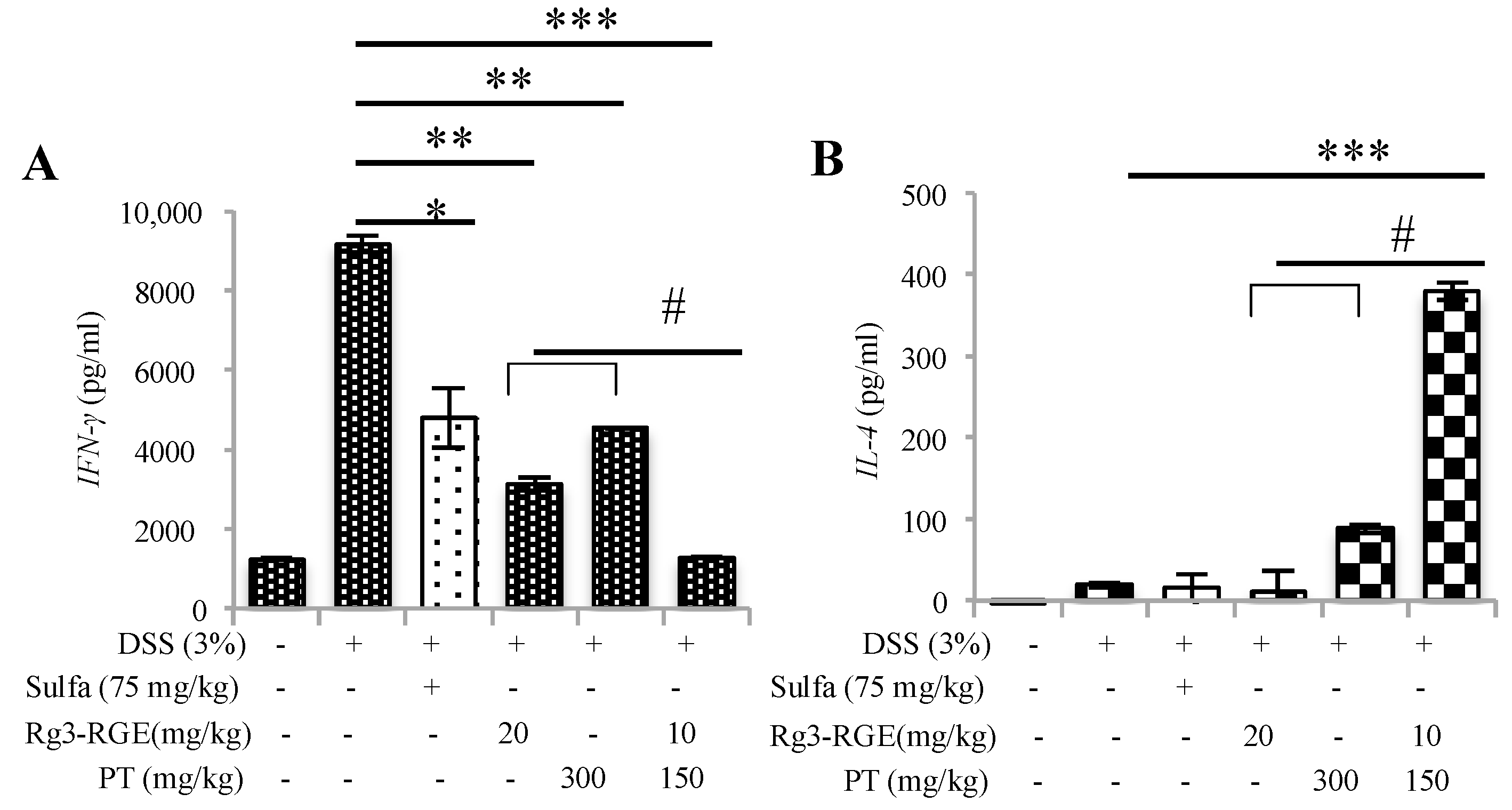
| Peak No. | ESI-MS RT (min) | UV (nm) | Detected Ion (m/z) [M−H]− | Calculated Ion (m/z) [M−H]− | Fragments | Molecular Formula | Identification |
|---|---|---|---|---|---|---|---|
| 1 | 3.37 | 254, 351 | 477.0648 | 477.0669 | 301 | C21H18O13 | Quercetin-3-O-β-d-glucuronide |
| 2 | 3.53 | 254, 354 | 607.1312 | 607.1299 | 505, 463, 301 | C27H28O16 | Quercertin-3-O-[6′′-O-(3-hydroxy-3-methylglutaryl)-β-d-glucopyranoside] |
| 3 | 3.70 | 268, 338 | 477.1031 | 477.1033 | 315, 299 | C22H22O12 | Isorhamnetin-3-O-β-d-glucopyranoside |
| 4 | 3.86 | 265, 346 | 591.1360 | 591.1350 | 447, 285 | C27H28O15 | Kaempferol-3-O-[6′′-(3-hydroxy-3-methylglutaryl)-β-d-glucopyranoside] |
| 5 | 4.51 | 277, 339 | 475.1005 | 475.0877 | 313 | C22H20O12 | 3,5,4′-Trihydroxy-6,7-methylenedioxyflavone-3-O-β-d-glucopyranoside |
| 6 | 4.60 | 277, 340 | 619.1486 | 619.1299 | 475, 313 | C28H28O16 | 3,5,4′-Trihydroxy-6,7-methylenedioxyflavone-3-O-[6′′-(3-hydroxy-3-methylglutaryl)- β-d-glucopyranoside] |
| 7 | 4.70 | 277, 339 | 517.1122 | 517.0982 | 475, 313 | C24H22O13 | 3,5,4′-Trihydroxy-6,7-methylenedioxyflavone-3-O-[6′′-(acetyl)-β-d-glucopyranoside] |
| 8 | 5.26 | 274, 339 | 531.0790 | 531.0775 | 471, 313 | C24H20O14 | 3,5,4′-Trihydroxy-6,7-methylenedioxyflavone-3-O-[2′′-(acetyl)-β-d-glucuronide] |
| 9 | 6.24 | 274, 351 | 313.0327 | 313.0348 | no fragment | C21H18O13 | 3,5,4′-Trihydroxy-6,7-methylenedioxyflavone |
| Gene | Primer | Oligonucleotide Sequence (5′-3′) | Accession Number |
|---|---|---|---|
| GAPDH | Forward | 5′-CAATGAATACGGCTACAGCAAC-3′ | BC023196.2 |
| Reverse | 5′-AGGGAGATGCTCAGTGTTGG-3′ | ||
| iNOS | Forward | 5′-CCCTTCCGAAGTTTCTGGCAGCAGC-3′ | NM_001313922.1 |
| Reverse | 5′-GGCTGTCAGAGCCTCGTGGCTTTGG-3′ | ||
| COX-2 | Forward | 5′- CAAGACGCCACATCCCCTAT -3′ | LC061973.1 |
| Reverse | 5′- ATTTAGTCGGCCTGGGATGG -3′ | ||
| IL-1β | Forward | 5′-CAGGGTGGGTGTGCCGTCTTTC-3′ | NM_008361.4 |
| Reverse | 5′-TGCTTCCAAACCTTTGACCTGGGC-3′ | ||
| TNF-α | Forward | 5′-TTGACCTCAGCGCTGAGTTG-3′ | NM_001278601.1 |
| Reverse | 5′-CCTGTAGCCCACGTCGTAGC-3′ | ||
| IL-6 | Forward | 5′-GTACTCCAGAAGACCAGAGG-3′ | NM_001314054.1 |
| Reverse | 5′-TGCTGGTGACAACCACGGCC-3′ | ||
| IL-5 | Forward | 5′-GAAGTGTGGCGAGGAGAGAC-3′ | BC125366.1 |
| Reverse | 5′- GCACAGTTTTGTGGGGTTTT-3′ | ||
| IL-13 | Forward | 5′-AGCATGGTATGGAGTGTGGA-3′ | NM_008355.3 |
| Reverse | 5′-TTGCAATTGGAGATGTTGGT-3′ | ||
| NLRP3 | Forward | 5′-TGCTCTTCACTGCTATCAAGCCCT-3′ | NM_145827.4 |
| Reverse | 5′-ACAAGCCTTTGCTCCAGACCCTAT-3′ |
Sample Availability: Samples of the compounds are available from the authors. | |
Publisher’s Note: MDPI stays neutral with regard to jurisdictional claims in published maps and institutional affiliations. |
© 2020 by the authors. Licensee MDPI, Basel, Switzerland. This article is an open access article distributed under the terms and conditions of the Creative Commons Attribution (CC BY) license (http://creativecommons.org/licenses/by/4.0/).
Share and Cite
Saba, E.; Lee, Y.Y.; Rhee, M.H.; Kim, S.-D. Alleviation of Ulcerative Colitis Potentially through th1/th2 Cytokine Balance by a Mixture of Rg3-enriched Korean Red Ginseng Extract and Persicaria tinctoria. Molecules 2020, 25, 5230. https://doi.org/10.3390/molecules25225230
Saba E, Lee YY, Rhee MH, Kim S-D. Alleviation of Ulcerative Colitis Potentially through th1/th2 Cytokine Balance by a Mixture of Rg3-enriched Korean Red Ginseng Extract and Persicaria tinctoria. Molecules. 2020; 25(22):5230. https://doi.org/10.3390/molecules25225230
Chicago/Turabian StyleSaba, Evelyn, Yuan Yee Lee, Man Hee Rhee, and Sung-Dae Kim. 2020. "Alleviation of Ulcerative Colitis Potentially through th1/th2 Cytokine Balance by a Mixture of Rg3-enriched Korean Red Ginseng Extract and Persicaria tinctoria" Molecules 25, no. 22: 5230. https://doi.org/10.3390/molecules25225230
APA StyleSaba, E., Lee, Y. Y., Rhee, M. H., & Kim, S.-D. (2020). Alleviation of Ulcerative Colitis Potentially through th1/th2 Cytokine Balance by a Mixture of Rg3-enriched Korean Red Ginseng Extract and Persicaria tinctoria. Molecules, 25(22), 5230. https://doi.org/10.3390/molecules25225230







